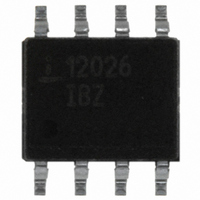ISL12026IBZ Intersil, ISL12026IBZ Datasheet - Page 18

ISL12026IBZ
Manufacturer Part Number
ISL12026IBZ
Description
IC RTC/CALENDAR EEPROM 8-SOIC
Manufacturer
Intersil
Type
Clock/Calendar/EEPROMr
Specifications of ISL12026IBZ
Memory Size
4K (512 x 8)
Time Format
HH:MM:SS (12/24 hr)
Date Format
YY-MM-DD-dd
Interface
I²C, 2-Wire Serial
Voltage - Supply
2.7 V ~ 5.5 V
Operating Temperature
-40°C ~ 85°C
Mounting Type
Surface Mount
Package / Case
8-SOIC (3.9mm Width)
Clock Format
HH
Clock Ic Type
RTC
Interface Type
I2C, Serial
Memory Configuration
512 X 8
Supply Voltage Range
2.7V To 5.5V
Digital Ic Case Style
SOIC
Rohs Compliant
Yes
Lead Free Status / RoHS Status
Lead free / RoHS Compliant
Available stocks
Company
Part Number
Manufacturer
Quantity
Price
Company:
Part Number:
ISL12026IBZ
Manufacturer:
INTELSEL
Quantity:
60
Part Number:
ISL12026IBZ
Manufacturer:
INTERSIL
Quantity:
20 000
Part Number:
ISL12026IBZ-T
Manufacturer:
INTERSIL
Quantity:
20 000
Acknowledge Polling
Disabling of the inputs during non-volatile write cycles can
be used to take advantage of the 12ms (typ) write cycle time.
Once the stop condition is issued to indicate the end of the
master’s byte load operation, the ISL12026 initiates the
internal non-volatile write cycle. Acknowledge polling can
begin immediately. To do this, the master issues a start
condition followed by the Memory Array Slave Address Byte
for a write or read operation (AEh or AFh). If the ISL12026 is
still busy with the non-volatile write cycle then no ACK will be
returned. When the ISL12026 has completed the write
operation, an ACK is returned and the host can proceed with
the read or write operation. Refer to the flow chart in
Figure 20. Note: Do not use the CCR Slave byte (DEh or
DFh) for Acknowledge Polling.
Read Operations
There are three basic read operations: Current Address
Read, Random Read and Sequential Read.
Current Address Read
Internally the ISL12026 contains an address counter that
maintains the address of the last word read incremented by
one. Therefore, if the last read was to address n, the next
read operation would access data from address n + 1. On
power-up, the 16-bit address is initialized to 00h. In this way,
a current address read immediately after the power on reset
can download the entire contents of memory starting at the
first location. Upon receipt of the Slave Address Byte with
the R/W bit set to one, the ISL12026 issues an
acknowledge, then transmits 8 data bits. The master
terminates the read operation by not responding with an
acknowledge during the ninth clock and issuing a stop
condition. Refer to Figure 19 for the address, acknowledge,
and data transfer sequence.
It should be noted that the ninth clock cycle of the read
operation is not a “don’t care.” To terminate a read operation,
the master must either issue a stop condition during the
ninth cycle or hold SDA HIGH during the ninth clock cycle
and then issue a stop condition.
Random Read
Random read operations allow the master to access any
location in the ISL12026. Prior to issuing the Slave Address
Byte with the R/W bit set to zero, the master must first
perform a “dummy” write operation.
The master issues the start condition and the slave address
byte, receives an acknowledge, then issues the word
address bytes. After acknowledging receipt of each word
address byte, the master immediately issues another start
condition and the slave address byte with the R/W bit set to
one. This is followed by an acknowledge from the device and
then by the 8-bit data word. The master terminates the read
operation by not responding with an acknowledge and then
issuing a stop condition. Refer to Figure 21 for the address,
acknowledge and data transfer sequence.
18
ISL12026, ISL12026A
In a similar operation called “Set Current Address,” the
device sets the address if a stop is issued instead of the
second start shown in Figure 21. The ISL12026 then goes
into standby mode after the stop and all bus activity will be
ignored until a start is detected. This operation loads the new
address into the address counter. The next Current Address
Read operation will read from the newly loaded address.
This operation could be useful if the master knows the next
address it needs to read, but is not ready for the data.
SIGNALS FROM
SIGNALS FROM
THE MASTER
SDA BUS
FIGURE 19. CURRENT ADDRESS READ SEQUENCE
THE SLAVE
FIGURE 20. ACKNOWLEDGE POLLING SEQUENCE
ISSUE MEMORY ARRAY SLAVE
CYCLE COMPLETE. CONTINUE
AFH (READ) OR AEH (WRITE)
COMMAND SEQUENCE?
NON-VOLATILE WRITE
ENTER ACK POLLING
NORMAL READ OR
WRITE COMMAND
COMPLETED BY
ADDRESS BYTE
ISSUING STOP.
ISSUE START
BYTE LOAD
RETURNED?
SEQUENCE
CONTINUE
PROCEED
ACK
S
A
R
T
T
1
YES
YES
ADDRESS
SLAVE
1
1
1
NO
NO
1
A
C
K
ISSUE STOP
ISSUE STOP
DATA
November 30, 2010
FN8231.9
O
S
T
P












